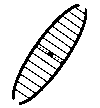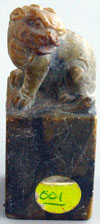 |
|
Desaru
ship |
13 July 2003
|
|||
| Last modified: 13 July 2003 |
The non-ceramic artefacts collected from within the ship's outline and immediate surroundings do not represent all the personal belongings which might be expected from an undisturbed site, but provide some insight into shipboard life. Missing from the wreck site were the ship's navigation equipment, blocks, tackles and other non-trade items likely to have been on deck, and therefore first to be displaced by fishing trawlers. Two sizes of cannon balls were found, but only one cannon, showing that even such heavy items must have been removed by trawlers.
One grappling anchor, three metres long, was retrieved. It has a long, heavy, tapered stock, with four prongs at one end and a ring for the anchor rope at the other. The maximum diameter of the stock is nineteen centimetres; the thinnest part is eleven centimetres. The anchor is cast in one piece and is estimated to weigh about 600 kg. It was found on the starboard side, between bulkheads eight and nine.
An iron carronade, about ninety-eight centimetres long, was found on the starboard side of the ship between bulkheads four and five, next to the hull. It appears to have been made in Scotland, based on the markings revealed when the surrounding concretion was removed. '1840' on one of the trunnions may represent the year of manufacture. Below this is 'No.3559', followed by '3:0:0' - probably serial numbers. The other trunnion was marked with an illegible name, probably the manufacturer, followed by 'Glasgow'. The marking '2.Pp' probablys indicate a calibre of two pounds, a short-range size commonly used for defence against pirates. Chinese junks at this time were allowed to carry a maximum of two short-range cannons.
A well-decorated bronze iron has a cast body, to accommodate hot charcoal, and a long wooden handle. The body is 10 cm in diameter and about 6 cm high. The base is flat and thin, while the decorated sides are rather thick.
 |
A shop's soapstone seal with a carved lion head was found in the ship's hold. Chinese characters engraved in the surface indicate the name of the shop: Sing Guan Hup. The name is probably of Hokkien origin; there 'Hup' means a combined or limited company, implying a larger corporation. The name suggests that it belonged to a company selling goods rather than providing a service. It is interesting to speculate whether the ceramic cargo may have belonged to a company about to set up a new shop at the ship's destination.
Pig bones were found on the site. Two left femora and one left tibia were sent for osteological analysis, which indicated that the bones were from at least two animals, most likely from the Sus species. Measurements and appearance indicated that the individuals were young juveniles. The bones showed no evidence of butchery. The pigs could therefore have been kept on board as livestock.(1)
Various parts of opium pipes or Yen Tsiang 'smoking pistols' were found scattered on the site. These consisted of lacquered bamboo stems and two brass opium chambers, once mounted on the stem. The opium chambers are hollow, and globular or octagonal in shape, with a tiny hole in the flat upper surface allowing air to enter the chamber.
A metal tobacco pipe was found in the northwest section of the wreck. It is thirty-eight centimetres high and was hammered or rolled in a mould into two circular halves joined by solder. The walls of the pipe are very thin. The lower container holds water to cool the smoke, while a missing upper container held the tobacco. The base of the pipe is inscribed with two names: Liew Bai Chau, followed by Chan Ta Chun Hau, likely to be the names of the owner and maker respectively. The mouthpiece is missing, and would probably have been made of wood, bone or ivory.
One hundred and forty six serving trays rolled from sheets of brass were recovered from the forward part of the ship. Most of these were stored in one concentrated area. These serving trays are used by the Malay people to serve dishes of food and are called 'talam tembaga' (tembaga meaning brass, and talam serving).
Other objects included part of a padlock, wall-mounted lamps, a scale, a carpenter's square, wood plane, inkdishes, inkbottles, tea caddies, a pestle and mortar, rope, and ships' fittings.
| Desaru ship overview | Maritime Asia homepage | Next: dating |